Sensor Data Format
How to save sensor data
While sensor is set up, press Space Key in Simulator.
The sensing data and label data are saved in SaveFile/SensorData/ director at time in which key is pressed.

Lidar Point Cloud
File format : bin file
The x, y, z intensity in the point cloud is saved a 1-D array in a 4-byte format in the .bin file without spacing. the Origin is defined as location at which the Lidar is mounted.

For Python users, point cloud can be loaded by using fromfile function from numpy as follows.

Setting Instance from intensity type for Lidar point cloud enables different intensities from vehicles and pedestrians. This is used to label different identities based on the varying shapes detected by Lidar.
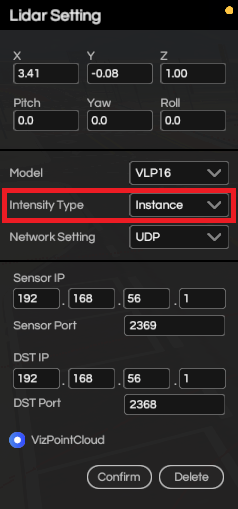
Class | Intensity (unsigned integer 8) |
|---|---|
Vehicle | 0 ~ 149 |
Pedestrian | 150 ~ 254. |
Obstacle | Random (50, 100, 150, 200, 250, 45, 90, …) Increases in increments of 50 |
File is saved in SaveFile/SensorData/LIDAR_*. The file name is automatically generated based on point time and date at which point cloud is saved.
3D Bounding Box
File format : txt file
3d bbox format in txt file
8 per object
1 : Classes of 3d bbox
Vehicle : 0
Pedestrian : 1
Object : 2
2-4 : Center of box in x, y, z format (unit: m) where the origin is defined as the Lidar.
5-7 : Box length (x-wise), width (y-wise), and height (z-wise) (unit: m).
8 : Box heading (z-wise counter-clockwise) (range : -pi ~ pi)
9-10 : Relative distance and velocity (units: m, m/s, respectively)
11 : Unique ID for each detected object

File is saved in SaveFile/SensorData/LIDAR_*, same location as that of Lidar point cloud. The file name is automatically generated based on point time and date at which point cloud is saved.
RGB Image
File format : jpeg file
To save as RGB format, after camera installation, select ‘None’ from Ground Truth field from Image View section in Camera Setting panel.
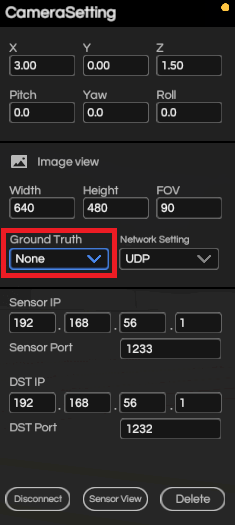
File is saved in SaveFile/SensorData/CAMERA_*. The file name is automatically generated based on point time and date at which point cloud is saved.
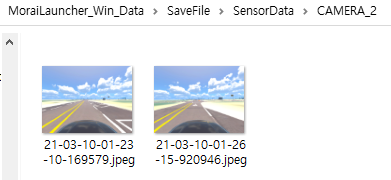
Semantic Segmentation Image
File format : png file
To save as semantic label images, after camera installation, select ‘Semantic’ from Ground Truth field from Image View section in Camera Setting panel.
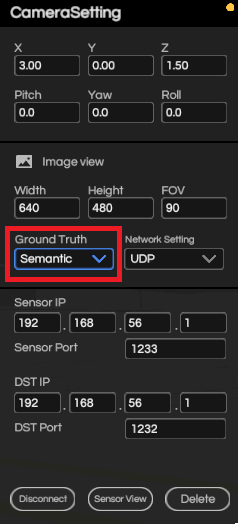
RBG values of segmentation image labelling map are as follows.
Class | R | G | B |
|---|---|---|---|
Sky | 5 | 245 | 255 |
ETC | 23 | 2 | 6 |
Asphalt | 127 | 127 | 127 |
Building | 153 | 255 | 51 |
Traffic Light | 255 | 74 | 240 |
Whit Lane | 255 | 255 | 255 |
Yellow Lane | 255 | 255 | 0 |
Blue Lane | 0 | 178 | 255 |
Road Sign | 204 | 127 | 51 |
Crosswalk | 76 | 255 | 76 |
Stop Line | 255 | 0 | 0 |
Sidewalk | 255 | 102 | 30 |
Road Edge | 178 | 178 | 178 |
Standing OBJ | 113 | 178 | 37 |
Object On Road | 178 | 9 | 90 |
Vehicle | 255 | 0 | 25 |
Pedestrian | 255 | 2 | 2 |
Files are named and saved in similar fashion as those for naming and saving RGB images.
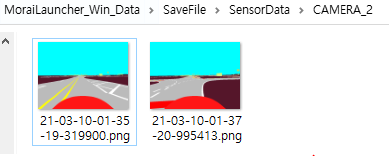
Instance Image
Image file format : png file
2d bbox labelling : txt file
To save instance label images and 2d bbox, after camera installation, select ‘Instance’ from Ground Truth field from Image View section in Camera Setting panel.
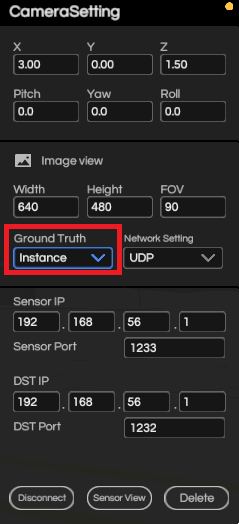
Instance label images are labelled with different pixel values even if they are of the same class, and thus, are differentiated with ID within each class.

2d bbox in txt file follows a similar format as the KITTI data set.
1 : 2d bbox classes
Vehicle
Pedestrian
Object
2 : Truncated(1), output equal to 0.
3 : Occluded(1), output equal to 0.
4 : Alpha(1), output equal to 0.
5-8 : Coordinates of upper left-hand, lower right-hand corners of 2d bbox. x1, y1, x2, y2, respectively.
9-11 : Object dimensions. Output equals to 0 since this field overlaps with point cloud 3d bbox
12-14 : Object location. Output equals to 0 since this field overlaps with point cloud 3d bbox
15 : Yaw angle of object. Output equals to 0 since this field overlaps with point cloud 3d bbox
16 : Relative distance between object and camera
17-19 : Relative velocity of object and camera x, y, z

Files are named and saved in similar fashion as those for naming and saving RGB images.

GPS data
File format : txt file
GPS data format inside txt file
1 : Latitude (unit : deg)
2 : Longitude (unit : deg)
3 : Altitude (unit : m)
4 : EastOffset (unit : m)
5 : NorthOffset (unit : m)
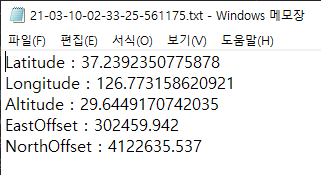
Files are saved in folder SaveFile/SensorData/GPS_*. Files are named as time and date at which the files are saved.
IMU data
File format : txt file
IMU data format in txt file
1-2 : TimeStamp. 1 in 1-second units, 2 in 1-nanosecond units.
3-6 : Orientation X, Y, Z, W. Quaternion angular velocity.
7-9 : Angular Velocity X, Y, Z for X, Y, Z axis components (unit : rad/s)
10-12 : Linear Acceleration X, Y, Z for X, Y, Z axis components (unit : m/s^2)
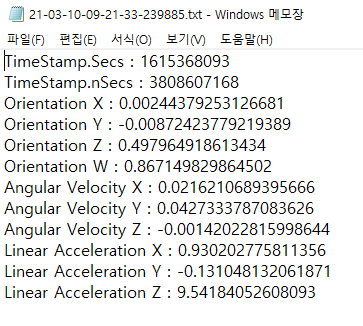
Files are saved in SaveFile/SensorData/IMU_*. Files are named as time and date at which the files are saved.
Radar Data
File format: bin file
Radar data, composed of position, velocity, and acceleration with respect to x, y, z axes components are saved as 4-byte data in a 1-D array format in the bin file. The origin is defined as the location at which the Radar is mounted.
1-3 : Position of cluster in x, y, z
4-6 : Velocity components of cluster in x, y, z
7-9 : Acceleration components of cluster in x, y, z
10-12 : Size of cluster in x, y, z
13 : Amplitude
For python users, data can be loaded using fromfile function of numpy as follows.
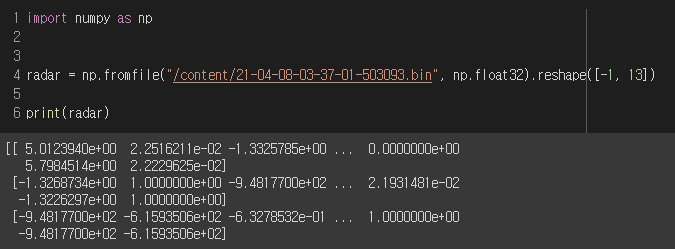
Files are saved in SaveFile/SensorData/RADAR_*. Saved file names are generated based on time and date at which point cloud is saved.
